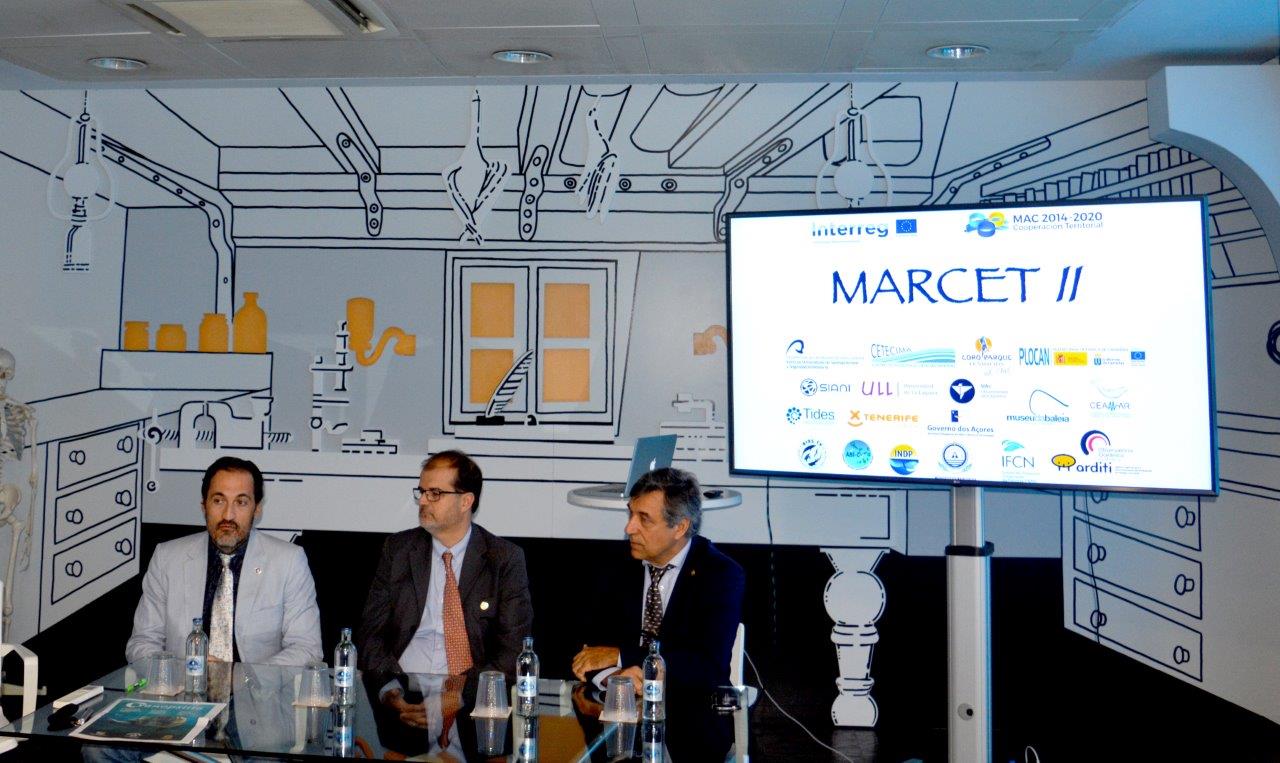The INTERREG project, known as MARCET, today begins its second stage of activity and launches several scientific and technological research studies that will, over the next three years, allow it to evaluate and analyse the impact of human activity in marine protected areas of the Macaronesian Atlantic, using cetaceans as protagonists, not only because they are considered emblematic species, but also because they are bioindicators of the healthy environmental status of the marine areas where they reside and umbrellas for the protection of the marine ecosystem. This project will also contribute to the development of environmental and economic sustainability criteria, with special attention to the activity of cetacean observation.
MARCET II is an initiative led by the University of Las Palmas de Gran Canaria, via the University Institute of Animal Health and Food Safety (IUSA-ULPGC) and has the direct participation of fifteen other institutions and organisations from the four Macaronesian archipelagos: PLOCAN, CETECIMA, The Loro Parque Foundation, Tenerife Tourism, CEAMAR, the University of La Laguna (ULL), Madeira’s Baleia Museum and Oceanic Observatory, the Institute of Forests and Conservation of Nature IFCN IP-RAM), the Regional Directorate of Sea Affairs (DRAM), the University of the Azores, Cap Verde’s National Directorate of the Environment, the National Institute of Fisheries Development (INDP), BIOS. CV and the Association of Biologists and Researchers of Cape Verde (ABI-CV).
At the initial working meeting of this second phase, which took place in the Elder Museum of Science and Technology, representatives of all participating entities were present and the inauguration was in the hands of the Director of the University Institute of Animal Health and promoter of the project, Antonio Fernández, accompanied by the Vice-rectors of Research, Innovation and Knowledge Transfer of the Universities of Las Palmas de Gran Canaria and the University of La Laguna, José Pablo Suárez Rivero and Ernesto Pereda, respectively.
“The evaluation of the impact generated by human activities on specific marine areas through the environmental, health and oceanographic studies proposed in the MARCET II Project will help to implement actions aimed at the protection and conservation of groups of cetaceans living in these areas and, by extension, of the entire marine ecosystem on which they depend,” said Antonio Fernández, but, above all, he added, “they will be useful in establishing ways to build a model of sustainable economic development and to guarantee a quality of life for all the species that inhabit the Macaronesian region, including human beings”.
For his part, Ernesto Pereda, stressed that “the multidisciplinary approach of the project is the most appropriate way to improve sustainability in the sighting of cetaceans and thus the life of Canarian society” thereby fulfilling the contribution of the transfer of knowledge made by the university. Along the same lines, his counterpart, Suárez Rivero, stressed the importance of the collaboration between the two Canarian universities, as well as the role of IUSA in the creation of knowledge networks and MARCET II “is exemplary in this sense”, he pointed out.
The first part of the MARCET project, which began in 2017 and has just ended, was created with the aim of transferring and disseminating cutting-edge science and technologies to promote the sustainable development of tourism associated with cetacean sighting, through the creation and implementation of the MARCET Network, an inter-regional and multidisciplinary network that brings together centres specialising in the surveillance and health monitoring of cetaceans and in operational oceanography, with the aim of integrating, harmonising and optimising knowledge, infrastructures and good practices in the region.
Thanks to the use of the now established MARCET Network, the harmonisation of working protocols and their integration to protect and conserve the cetacean populations of Macaronesia from a multidisciplinary point of view, and the knowledge acquired on the current situation of the tourism sector associated with the observation activity of these species in the region, this new initiative, the MARCET II Project, has been created, with the aim of increasing the value of this activity as a model of sustainable economic development in the Macaronesian archipelagos (Azores, Madeira, Canary Islands and Cape Verde), thus strengthening the ecotourism market niche that this activity represents and, at the same time, establishing sustainability criteria applied to the resident cetacean species that serve as a tourist attraction.
To this end, MARCET II is technically structured in three specific objectives, the first, considered key to the establishment of ecological and environmental sustainability criteria, integrates the use of advanced techniques of operational oceanography, as well as the monitoring and sanitary surveillance of cetaceans resident in marine protected areas and of special interest for this ecotourism activity in the Macaronesia, using as the main indicator species the Bottlenose Dolphin (Tursiops truncatus) and the Pilot Whale (Globicephala macrorhynchus), to evaluate the possible presence of risk factors of anthropogenic origin linked to these marine areas.
The other two objectives are aimed at enhancing the value of cetaceans as a natural heritage and as a differentiated economic resource of special importance for the associated ecotourism sector in the Macaronesian region. In this respect, actions will be carried out to disseminate and raise awareness of the diversity of cetacean species existing in the region, as well as the importance of protecting and conserving the marine areas in which they reside. The third specific objective is to strengthen the entrepreneurial activity of cetacean observation as a model of sustainable economic development in the Macaronesian region.














